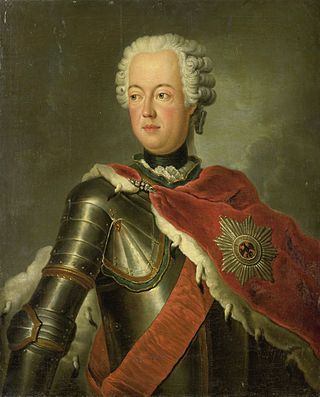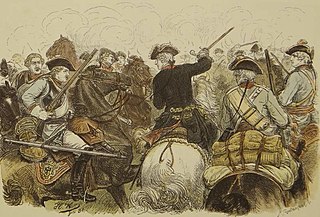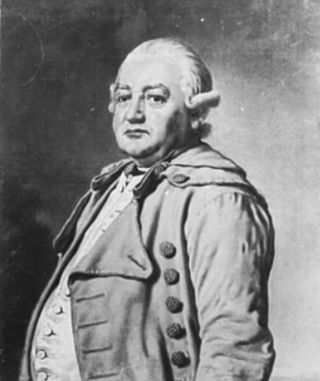
Frederick William was Elector of Brandenburg and Duke of Prussia, thus ruler of Brandenburg-Prussia, from 1640 until his death in 1688. A member of the House of Hohenzollern, he is popularly known as "the Great Elector" because of his military and political achievements. Frederick William was a staunch pillar of the Calvinist faith, associated with the rising commercial class. He saw the importance of trade and promoted it vigorously. His shrewd domestic reforms gave Prussia a strong position in the post-Westphalian political order of Northern-Central Europe, setting Prussia up for elevation from duchy to kingdom, achieved under his son and successor.

The County of Mark was a county and state of the Holy Roman Empire in the Lower Rhenish–Westphalian Circle. It lay south of Lippe river on both sides of the Ruhr river along the Volme and Lenne rivers.

Brandenburg-Prussia is the historiographic denomination for the early modern realm of the Brandenburgian Royal dynasty of the House of Hohenzollern between 1618 and 1701. Based in the Electorate of Brandenburg, the main branch of the Hohenzollern intermarried with the branch ruling the Duchy of Prussia, and secured succession upon the latter's extinction in the male line in 1618.

The Kingdom of Prussia constituted the German state of Prussia between 1701 and 1918. It was the driving force behind the unification of Germany in 1866 and was the leading state of the German Empire until its dissolution in 1918. Although it took its name from the region called Prussia, it was based in the Margraviate of Brandenburg. Its capital was Berlin.

Prussia was a German state centred on the North European Plain that originated from the 1525 secularization of the Prussian part of the State of the Teutonic Order. The Knights had to relocate their headquarters to Mergentheim, but managed to keep land in Livonia until 1561.

South Prussia was a province of the Kingdom of Prussia from 1793 to 1807 created out of territory annexed in the Second Partition of Poland.

The Prussian Ministry of War was the highest state authority of the Prussian Army and was responsible for the central administration of the army of the Kingdom of Prussia and, later, the Imperial German Army. The ministry existed from 1808 through the establishment of the German Empire and was dissolved in 1919, being succeeded by the Ministry of the Reichswehr.
Following the defeats Prussia suffered in the 30 Years' War, Frederick William, Elector of Brandenburg, set up the General War Commissariat (General-Kriegs-Kommissariat) to oversee the army, as well as to levy taxes necessary to support the army. It soon became a bureaucratic machine for civil government as well. Frederick William used it to govern the state. Many members were landed aristocracy known as Junkers, who served in the army as well. The commissariats helped to centralize power. It later was merged into General Directory of War and Finance in 1723. Joachim Friedrich von Blumenthal was its first head since 1646. During the reign of Frederick William I, Friedrich Wilhelm von Grumbkow became its head.

Hans Karl von Winterfeldt, a Prussian general, served in the War of the Polish Succession, the War of Austrian Succession, Frederick the Great's Silesian wars and the Seven Years' War. One of Frederick's trusted confidantes and advisors, he attracted enmity from other courtiers. Frederick entrusted him with considerable autonomy on the general staff, and Winterfeldt developed the first "modern" program of military intelligence gathering. He negotiated the Convention of Westminster and, for his efforts on Frederick's behalf, received the Order of the Black Eagle and the Order Pour le Mérite. He died from wounds received at Battle of Moys. His name is included on the Equestrian statue of Frederick the Great.

Prince Augustus William of Prussia was the son of King Frederick William I of Prussia and a younger brother and general of Frederick the Great.

The Royal Prussian Army served as the army of the Kingdom of Prussia. It became vital to the development of Prussia as a European political and military power and within Germany.

The First Silesian War was a war between Prussia and Austria that lasted from 1740 to 1742 and resulted in Prussia's seizing most of the region of Silesia from Austria. The war was fought mainly in Silesia, Moravia and Bohemia and formed one theatre of the wider War of the Austrian Succession. It was the first of three Silesian Wars fought between Frederick the Great's Prussia and Maria Theresa's Austria in the mid-18th century, all three of which ended in Prussian control of Silesia.
The Canton System or Canton Regulation was a system of recruitment used by the Prussian army between 1733 and 1813. The country was divided into recruiting districts called cantons, and each canton was the responsibility of a regiment. The system was distinctly Prussian. Every male was from the youngest possible age enrolled in the army, and by 1740 the Prussian army, with a strength of 3.6% of the total population, was proportionately the largest in Europe. The new system replaced coercive recruiting, which in turn replaced the hiring of undependable and expensive mercenary forces. It allowed the army to double from 38,000 to 76,000, making it the fourth largest in Europe, and it linked the local population more closely to the royal government.

Friedrich Wilhelm von Grumbkow was a Prussian Generalfeldmarschall and statesman.

The Royal Prussian Army was the principal armed force of the Kingdom of Prussia during its participation in the Napoleonic Wars.

The Province of Pomerania was a province of Brandenburg-Prussia, the later Kingdom of Prussia. After the Thirty Years' War, the province consisted of Farther Pomerania. Subsequently, the Lauenburg and Bütow Land, Draheim, and Swedish Pomerania south of the Peene river were joined into the province. The province was succeeded by the Province of Pomerania set up in 1815.
The Treaty of Paris of 24 February 1812 between Napoleon I of France and Frederick William III of Prussia established a Franco-Prussian alliance directed against Russia. On 24 June, Prussia joined the French invasion of Russia. The unpopular alliance broke down when the Prussian contingent in French service signed a separate armistice, the Convention of Tauroggen, with Russia on 30 December 1812. On 17 March 1813, Frederick William declared war on France and issued his famous proclamation "To My People".

Franz Balthasar Schönberg von Brenkenhoff (1723-1780) was a Prussian secret financial adviser. He was the head of the Netze District and the builder of the Bromberger Kanal.

The Prussian State Ministry from 1808 to 1850 was the executive body of ministers, subordinate to the King of Prussia and, from 1850 to 1918, the overall ministry of the State of Prussia consisting of the individual ministers. In other German states, it corresponded to the state government or the senate of a free city.















